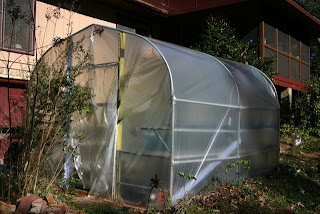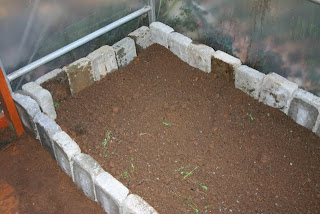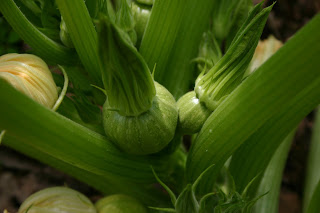
Sunday i finished the bed on the south side of the greenhouse and planted it with a variety of different vegetables which i will talk about in a little while. Today my friend and mentee Chesley came over and we prepped the north side bed and installed the paver stone path. It took a total of 10 person-hours to complete this little project. It cost no money because i had everything we needed.
I want to point out a couple of seemingly minor details that will have an effect on how things grow and on the management of the space.
Notice that the stones lining inside of the bed on the south side (right side in the photo) are taller that the stones lining the bed on the north side. On the south side i want the sun to hit the stones to warm them and the adjacent soil. If i used tall stones on the north side 8-12" of the soil would be shaded by them due to the low angle of the sun this time of year.
I sowed lettuce seeds along the stones in the south bed. Lettuce will benefit from the warmer microclimate adjacent to the stones.
In the corners and around the bench post there are spaces where pavers would not fit. I know from experience that unwanted plants will find their way into the greenhouse (like bermuda grass, ugh!). I plan to plant something tough, probably welsh onions, in those nooks and crannies to beat mother nature to the punch.

Practicing what i preach i have a plan in mind for the space. The intent here is to supplement what is growing outside during times when it is really cold and the plants are covered and at the end of the winter season while newly planted crops outdoors are beginning to grow. The goal is to grow food from many different plant families. Different families of plants accumulate nutrients in different concentrations. By having a wide variety we will maximize our nutrient intake when we eat the plants. i planted everything closely together. First we will eat the thinnings. Then we will eat the plants when they are still small, in the case of greens by harvesting the outer leaves. Everything from this space will be eaten raw.
Permaculturists, this space is in
zone 1, just outside the back door, easily accessible from the house.
When will things be ready to harvest? I have no idea really. It will depend on the weather. The more sunny days we get the faster it will happen. If i had to guess i would say it will be 2 months before we get much of anything from the space.
Next fall i will plant the space in october, so things will have tine to grow before cold weather sets in. Of course with global climate change one cannot count on history to predict what the weather will be next month let alone next year.
I plan to start some tomatoes in the greenhouse in march. I hope to be able to have ripe tomatoes at least a month early. I will plant a determinate, early maturing variety called Taxi which i have grown before. It is a very tasty, sweet, yellow variety. Determinate means it grows to a certain height, 3-4', and stops unlike indeterminate varieties that act like vines and keep on growing all season. I will plant some heat loving peppers and eggplant too. Also i will probably try some pink-eyed purple hull crowder peas as a legume cover crop late in the summer. They love heat and are drought tolerant so should do well.
It has been very gratifying to do this project. This time of year it is good for me to do some physical work that moves us forward.It helps my psyche as well. We will see what happens.
I will report back when something comes up.
 WHAT WE PLANTED SO FAR:
WHAT WE PLANTED SO FAR:Chinese cutting celery - transplanted volunteer seedlings from the garden
Dinosaur kale - left over starter plants
Lettuce - Jericho, Outredgeous Red
Arugula - Astro,
Carrot - Purple Dragon, Scarlet Nantes, Red Core Chantenay
Asian Greens - Hon Tsai Tai, Red Komatsuna
Spinach - 7-green smooth leaf
Fennel - Zefa Fino
Welsh Onion - saved seed
Chard - Barese dwarf
Cilantro - Santo
Radish - d'Avignon
Radish Greens - Hong Vit
Mustard - Osaka Purple
Leek - King Richard
Borage


 Practicing what i preach i have a plan in mind for the space. The intent here is to supplement what is growing outside during times when it is really cold and the plants are covered and at the end of the winter season while newly planted crops outdoors are beginning to grow. The goal is to grow food from many different plant families. Different families of plants accumulate nutrients in different concentrations. By having a wide variety we will maximize our nutrient intake when we eat the plants. i planted everything closely together. First we will eat the thinnings. Then we will eat the plants when they are still small, in the case of greens by harvesting the outer leaves. Everything from this space will be eaten raw.
Practicing what i preach i have a plan in mind for the space. The intent here is to supplement what is growing outside during times when it is really cold and the plants are covered and at the end of the winter season while newly planted crops outdoors are beginning to grow. The goal is to grow food from many different plant families. Different families of plants accumulate nutrients in different concentrations. By having a wide variety we will maximize our nutrient intake when we eat the plants. i planted everything closely together. First we will eat the thinnings. Then we will eat the plants when they are still small, in the case of greens by harvesting the outer leaves. Everything from this space will be eaten raw. WHAT WE PLANTED SO FAR:
WHAT WE PLANTED SO FAR:






